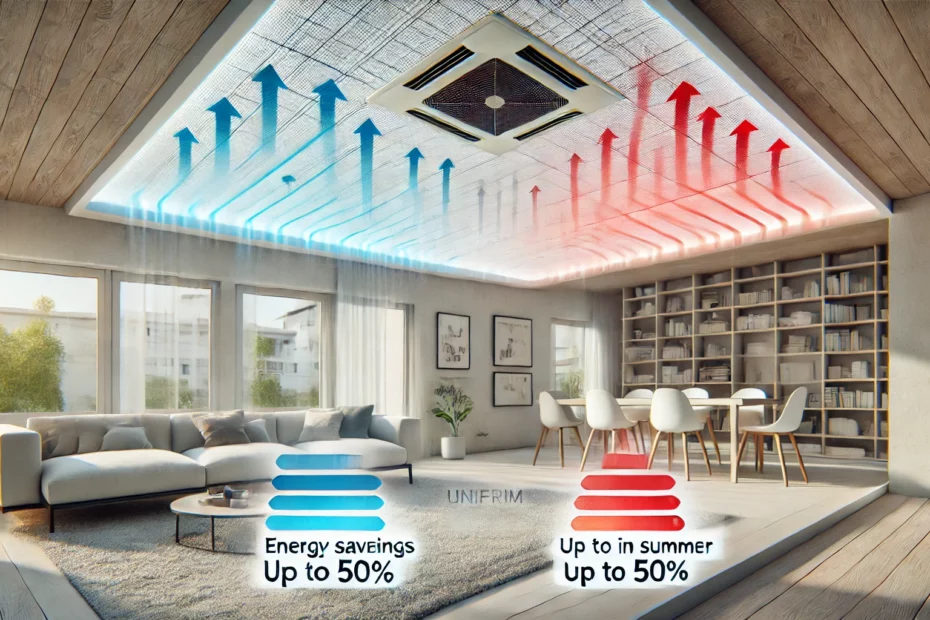Choosing the best heating solution for a traditional building can seem complex, given the variety of options available. Heated ceilings, connected radiators, heat pumps… each of these technologies offers its own advantages. But when it comes to optimizing energy consumption and guaranteeing unrivalled comfort, heating and cooling ceilings stand out as the ideal solution.
Ceiling heating/cooling: the perfect blend of discretion and performance
Heating and cooling ceilings are the most efficient solution for all types of traditional buildings. Why is this? Because it provides even heat distribution in winter and pleasant coolness in summer, without creating air or dust movements. This absence of air circulation avoids sudden temperature variations and guarantees a constant feeling of well-being.
When it comes to energy consumption, the heated ceiling excels: using radiant technology, it provides gentle, efficient heat distribution, considerably reducing energy requirements. With energy savings of up to 50% compared to traditional heating systems, it’s the ideal choice for homeowners concerned with minimizing their energy bills.

The other major advantage of ceiling heating is its invisibility. Installed directly in the ceiling, it completely frees up wall space, offering greater freedom to design rooms without having to integrate radiators or other visible elements. This discretion preserves the aesthetics of homes and offices, while providing optimum comfort.
Connected radiators: flexibility and remote management
Connected radiators are an interesting alternative for those looking for a flexible solution. Their main advantage lies in the ability to manage temperature remotely via an app, enabling precise control of consumption. They come in a range of customizable designs, making them suitable for all types of décor, whether for shops, offices or homes.
However, in terms of consumption, connected radiators are still less efficient than ceiling heaters. Although they are more economical than traditional radiators, they cannot match the energy efficiency of a radiant heating system.
Heat pump: an ecological but bulky solution
Heat pumps are another option often considered for commercial buildings or large homes. It uses natural resources to heat or cool spaces, making it an environmentally-friendly solution. However, its installation requires more space, especially for outdoor units, and its energy efficiency is more interesting for large surfaces than for small spaces.
In terms of comfort, heat pumps can generate draughts, unlike heated ceilings, which can lead to less uniform sensations of cold or heat.
Final comparison: heating/cooling ceilings, the choice of excellence
When it comes to discretion, energy efficiency and maximum comfort, heating and cooling ceilings are by far the best option. In addition to drastically reducing energy consumption, it guarantees exceptional thermal comfort in both summer and winter, while remaining invisible. It’s the perfect solution for traditional buildings, whether homes, offices or shops, where aesthetics and space saving are priorities.
Connected radiators will appeal to those who prefer flexibility and remote management, but remain less efficient in terms of consumption. Choosing the best heating solution for a traditional building can seem complex, given the variety of options available. Heated ceilings, connected radiators, heat pumps… each of these technologies offers its own advantages. But when it comes to optimizing energy consumption and guaranteeing unrivalled comfort, ceiling heating and cooling stands out as the ideal solution.
Ceiling heating/cooling: the perfect blend of discretion and performance
Heating and cooling ceilings are the most efficient solution for all types of traditional buildings. Why is this? Because it provides even heat distribution in winter and pleasant coolness in summer, without creating air or dust movements. This absence of air circulation avoids sudden temperature variations and guarantees a constant feeling of well-being.
When it comes to energy consumption, the heated ceiling excels: using radiant technology, it provides gentle, efficient heat distribution, considerably reducing energy requirements. With energy savings of up to 50% compared to traditional heating systems, it’s the ideal choice for homeowners concerned with minimizing their energy bills.
The other major advantage of ceiling heating is its invisibility. Installed directly in the ceiling, it completely frees up wall space, offering greater freedom to design rooms without having to integrate radiators or other visible elements. This discretion preserves the aesthetics of homes and offices, while providing optimum comfort.
Connected radiators: flexibility and remote management
Connected radiators are an interesting alternative for those looking for a flexible solution. Their main advantage lies in the ability to manage temperature remotely via an app, enabling precise control of consumption. They come in a range of customizable designs, making them suitable for all types of décor, whether for shops, offices or homes.
However, in terms of consumption, connected radiators are still less efficient than ceiling heaters. Although they are more economical than traditional radiators, they cannot match the energy efficiency of a radiant heating system.
Heat pump: an ecological but bulky solution
Heat pumps are another option often considered for commercial buildings or large homes. It uses natural resources to heat or cool spaces, making it an environmentally-friendly solution. However, its installation requires more space, especially for outdoor units, and its energy efficiency is more interesting for large surfaces than for small spaces.
In terms of comfort, heat pumps can generate draughts, unlike heated ceilings, which can lead to less uniform sensations of cold or heat.
Final comparison: heating/cooling ceilings, the choice of excellence
Ultimately, for those seeking discretion, energy efficiency and maximum comfort, a heating and cooling ceiling is by far the best option. In addition to drastically reducing energy consumption, it guarantees exceptional thermal comfort in summer and winter, while remaining invisible. It’s the perfect solution for traditional buildings, whether homes, offices or shops, where aesthetics and space saving are priorities.
Connected radiators will appeal to those who prefer flexibility and remote management, but remain less efficient in terms of consumption. As for heat pumps, they are an interesting option for large surfaces, but require suitable spaces for installation.

